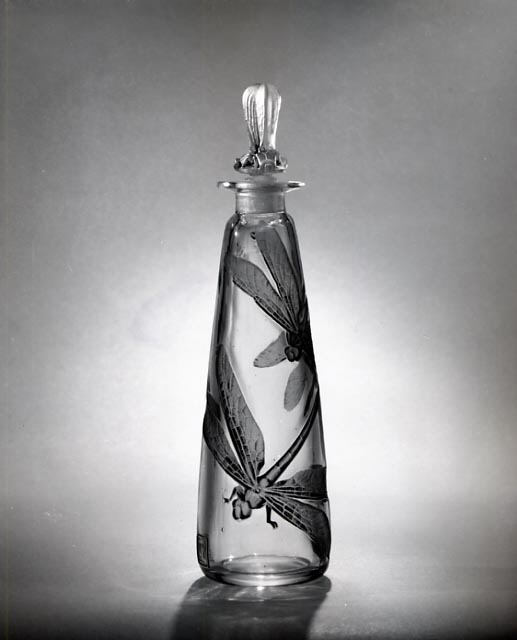|
Lucien Gaillard
Lucien Gaillard (1861 – 1942, both in Paris, France) was a French goldsmith and jeweller, who worked in the art nouveau style. Lucien Gaillard was born into a family of jewellers. His grandfather Amédée Alexandre Gaillard (1811-1882) founded a jewellery firm in Paris in 1840, which he then passed on to his son Ernest (1836-1909). Lucien Gaillard trained as an apprentice under his father, before taking over the business in 1892. His brother Eugéne was also a well known art nouveau furniture designer. He was a contemporary of René Lalique. He won a prize for his jewellery at the 1889 Universal Exposition. He was also a judge at the 1893 Universal Exposition in Chicago. In 1902 he was made a knight of the Legion of Honour. He was deeply interested in Japanese art. His workshop included artists who travelled from Japan to work in ivory and lacquer. He also worked in copper. His workshop produced vases, cane heads, hair combs, pins and pendants as well as more tradition ... [...More Info...] [...Related Items...] OR: [Wikipedia] [Google] [Baidu] |
Paris
Paris () is the capital and most populous city of France, with an estimated population of 2,165,423 residents in 2019 in an area of more than 105 km² (41 sq mi), making it the 30th most densely populated city in the world in 2020. Since the 17th century, Paris has been one of the world's major centres of finance, diplomacy, commerce, fashion, gastronomy, and science. For its leading role in the arts and sciences, as well as its very early system of street lighting, in the 19th century it became known as "the City of Light". Like London, prior to the Second World War, it was also sometimes called the capital of the world. The City of Paris is the centre of the Île-de-France region, or Paris Region, with an estimated population of 12,262,544 in 2019, or about 19% of the population of France, making the region France's primate city. The Paris Region had a GDP of €739 billion ($743 billion) in 2019, which is the highest in Europe. According to the Economist Intelli ... [...More Info...] [...Related Items...] OR: [Wikipedia] [Google] [Baidu] |
René Lalique
René Jules Lalique (6 April 1860 – 1 May 1945) was a French jeweller, medallist, and glass designer known for his creations of glass art, perfume bottles, vases, jewellery, chandeliers, clocks, and automobile hood ornaments. Life Lalique's early life was spent learning the methods of design and art he would use in his later life. At the age of two, his family moved to the suburbs of Paris, but traveled to Aÿ for summer holidays. These trips influenced Lalique later on in his naturalistic glasswork. With the death of his father, Lalique began working as an apprentice to goldsmith Louis Aucoc in Paris. Lalique died on 1 May or 5 May 1945, in Paris. René Lalique was buried in Père Lachaise Cemetery in Paris, France. His granddaughter, Marie Claude-Lalique (b. 1936), was also a glass maker. She died on 14 April 2003 in Fort Myers, Florida. Education In 1872, when he was twelve, he entered the Collège Turgot where he started drawing and sketching. He attended evening cla ... [...More Info...] [...Related Items...] OR: [Wikipedia] [Google] [Baidu] |
Plique-à-jour
''Plique-à-jour'' (French for "letting in daylight") is a vitreous enamelling technique where the enamel is applied in cells, similar to cloisonné, but with no backing in the final product, so light can shine through the transparent or translucent enamel. It is in effect a miniature version of stained-glass and is considered very challenging technically: high time consumption (up to 4 months per item), with a high failure rate. The technique is similar to that of cloisonné, but using a temporary backing that after firing is dissolved by acid or rubbed away. A different technique relies solely on surface tension, for smaller areas. In Japan the technique is known as shotai-jippo (shotai shippo), and is found from the 19th century on. History The technique was developed in the Byzantine Empire in 6th century AD. Some examples of Byzantine plique-à-jour survived in Georgian icons. The technique of plique-à-jour was adopted by Kievan Russia (a strong trading partner of Const ... [...More Info...] [...Related Items...] OR: [Wikipedia] [Google] [Baidu] |
Perfume Bottle MET Sf
Perfume (, ; french: parfum) is a mixture of fragrant essential oils or aroma compounds (fragrances), fixatives and solvents, usually in liquid form, used to give the human body, animals, food, objects, and living-spaces an agreeable scent. The 1939 Nobel Laureate for Chemistry, Leopold Ružička stated in 1945 that "right from the earliest days of scientific chemistry up to the present time, perfumes have substantially contributed to the development of organic chemistry as regards methods, systematic classification, and theory." Ancient texts and archaeological excavations show the use of perfumes in some of the earliest human civilizations. Modern perfumery began in the late 19th century with the commercial synthesis of aroma compounds such as vanillin or coumarin, which allowed for the composition of perfumes with smells previously unattainable solely from natural aromatics. History The word ''perfume'' derives from the Latin ''perfumare'', meaning "to smoke throu ... [...More Info...] [...Related Items...] OR: [Wikipedia] [Google] [Baidu] |



